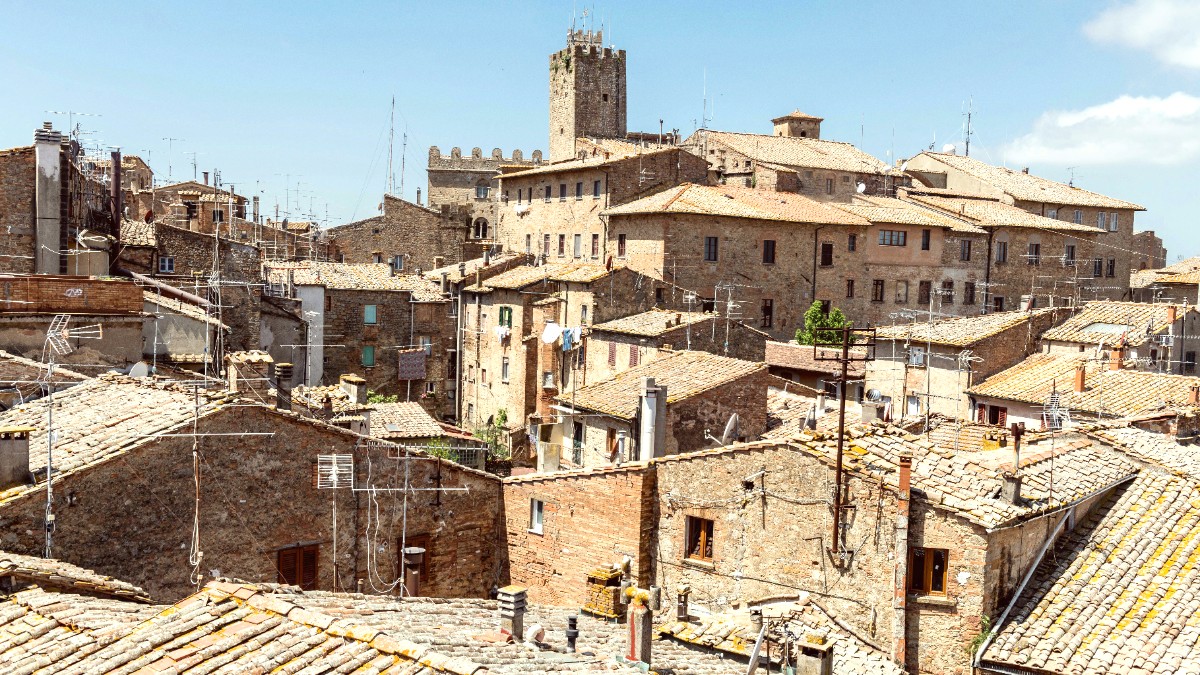
Tuscany, Italy
Tuscan cuisine, specifically in Volterra, draws heavily from "cucina povera," emphasizing resourcefulness and flavor. Historically, the region relied on grains, legumes, vegetables, wild game, and Chianina beef. Olive oil, bread, and wine form fundamental meal staples.
Local ingredients include extra virgin olive oil, unsalted Tuscan bread, wild game (especially cinghiale), Pecorino cheese (Volterra's specialty), autumn truffles, beans (fagioli), and aromatic herbs like rosemary and sage.
Volterra's cuisine bears an inland, rural influence, with strong emphasis on hearty meat dishes, local pecorino cheese, and forest products like truffles. Coastal Tuscany often features more seafood.
Light, typically a pastry (cornetto) and coffee (cappuccino or espresso), often enjoyed quickly at a bar.
Lunch ranges from a full meal to a quick panino. Dinner, the main meal, starts later, often a leisurely affair with multiple courses.
Wide egg noodles with a rich, slow-cooked wild boar ragù. A quintessential Tuscan dish.
Discoverable at many trattorias throughout Volterra.
A hearty vegetable and bread soup, often with beans. This dish reflects the "cucina povera" tradition.
A satisfying, warm meal, commonly found in traditional eateries.
Thick-cut, rare T-bone steak (typically Chianina beef), often cooked over coals. Order by weight, usually for two or more.
A flavorful meat experience available in many Tuscan restaurants.
Freshly made sandwiches (panini) at delis ("alimentari") or bars. Pizzerias offer varied toppings.
Held on Saturdays, the market presents local produce, cheeses, and cured meats for direct experience of flavors.
Finding vegetarian options is relatively easy. Many restaurants accommodate vegetarian requests.
Vegan choices can be more challenging but are gaining presence. Clear communication of needs helps.
Awareness of gluten-free (senza glutine) needs is growing. Awareness for other allergens is also improving.
Halal and kosher options are very limited to non-existent in Volterra.
Travelers with these specific needs should plan to prepare their own meals from supermarket ingredients or choose naturally vegan/vegetarian options.
Staying in an apartment or agriturismo with kitchen facilities presents the easiest path to manage strict dietary needs, allowing ingredient control.
Explore local markets for fresh, raw ingredients.
Use apps or cards.
Review sites for tags.
Apartments with kitchens.
Speak to restaurant staff.
Dining in a traditional trattoria within Volterra's historic walls creates an authentic atmosphere.
Enjoy hearty portions and welcoming service.
Experience authentic meals at an agriturismo, often featuring ingredients grown on site, a true taste of the local terroir.
Directly savor local flavors.
While Volterra has limited "fine dining" in the Michelin-star sense, several establishments present an upscale Tuscan dining experience.
International cuisine choices are limited, as Volterra is built around traditional Tuscan fare.
Hours vary seasonally for most sites (e.g., Roman Theatre 10:00 AM - 5:00/6:00 PM).
Entrance fees for sites like the Roman Theatre are approximately €5-€8.
Local tour guides lead historical and cultural walking tours.
One of Italy's most important Etruscan museums, housing the "Ombra della Sera" bronze figure and hundreds of funerary urns.
A deep dive into Volterra's ancient roots.
Dedicated to Volterra's alabaster carving tradition. Pinacoteca features paintings from the Middle Ages to the 19th century.
Showcases both local crafts and Tuscan art history.
Numerous private alabaster workshops and galleries ("botteghe") showcase local artisans' work throughout the historic center.
The Roman Theatre occasionally hosts performances and events. Teatro Persio Flacco stages local plays and concerts.
Check the official Volterra tourism website (Www.volterratur.it) or the local tourist office for current special exhibitions.
Many attractions are within walking distance in the historic center, but note the hilly terrain and cobblestone streets. Comfortable footwear is always a good idea.